
The Minneapolis Armory is a historic event center and former National Guard armory located in Downtown Minneapolis, Minnesota, United States. Built by the Public Works Administration in 1936, the building was occupied by several Army and Naval Militia units of the Minnesota National Guard from its opening until 1985. The building is listed on the National Register of Historic Places.
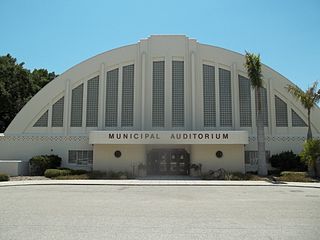
The Sarasota Municipal Auditorium, listed in the National Register as Municipal Auditorium-Recreation Club, is a historic multi-purpose facility built-in 1938. It is located at 801 Tamiami Trail North and is owned/operated by the municipal government of Sarasota, Florida. The auditorium has 10,000 square feet (930 m2) of exhibit space on its main floor and also contains an Art Deco style stage measuring 1,500 square feet (140 m2).

The Old Pascagoula High School is a building in Pascagoula, Jackson County, Mississippi. It opened in January 1939 and closed in June 1997.

The Deerwood Auditorium is a community center in Deerwood, Minnesota, United States. It was built as a New Deal project from 1935 to 1937. In 1995 the auditorium was listed on the National Register of Historic Places for its local significance in the themes of architecture, politics/government, and social history. It was nominated for being an exemplary multipurpose municipal building funded by the New Deal, as well as Minnesota's largest project by the State Emergency Relief Administration, and a longstanding venue for community events.
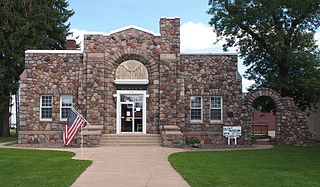
The Milaca Municipal Hall or Milaca City Hall, located at 145 Central Ave, South in Milaca, Minnesota, United States, was built using fieldstone, brick, and concrete. The building is a typical example of construction performed by the Works Progress Administration during the Great Depression. One hundred fifty-five workers and six superintendents labored to construct the flagstone-faced municipal hall. The building provided space for the fire department and village council in the back of the building, for a library in the south end, and a community kitchen to the left of the entry adjacent to a 200-seat auditorium. The American Legion had space in the basement. The facility was also available for use by church and service organizations. The building currently serves as the local museum and history center. Artwork was funded by the Federal Arts Project and executed by André Boratko.

Hyde Park Elementary School is located on US 9 in Hyde Park, New York, United States. It served students from kindergarten through fifth grade in the Hyde Park Central Schools.

Buchanan County Court House in Independence, Iowa, United States was built in 1940. It was listed on the National Register of Historic Places in 2003 as a part of the PWA-Era County Courthouses of IA Multiple Properties Submission. The current structure is the third courthouse to house court functions and county administration.

The Humboldt County Courthouse is located in Dakota City, Iowa, United States, and dates from 1939. It was listed on the National Register of Historic Places in 2003 as a part of the PWA-Era County Courthouses of IA Multiple Properties Submission. The courthouse is the second building the county has used for court functions and county administration.

The Des Moines County Court House located in Burlington, Iowa, United States, was built in 1940. It was listed on the National Register of Historic Places in 2003 as a part of the PWA-Era County Courthouses of Iowa Multiple Properties Submission. The courthouse is the fourth structure to house court functions and county administration.

The Warren County Courthouse is located in Indianola, Iowa, United States. The courthouse that was built in 1939 was listed on the National Register of Historic Places (NRHP) in 2003 as a part of the PWA-Era County Courthouses of IA Multiple Properties Submission. It was the third building the county has used for court functions and county administration. The building was demolished in the summer of 2019 and removed from the NRHP in September of the same year. A new courthouse and justice center is expected to be completed in 2022.

The Cass County Courthouse in Atlantic, Iowa, United States, was built in 1934 as the first courthouse in the state built with funding from the Public Works Administration (PWA). It was listed on the National Register of Historic Places in 2003 as a part of the PWA-Era County Courthouses of Iowa Multiple Properties Submission. The courthouse is the third structure to house court functions and county administration.
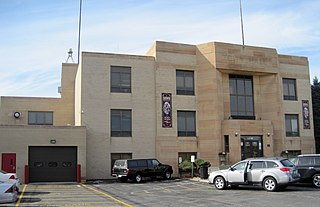
The Berwyn Municipal Building, also known as Berwyn City Hall, is a historic public building located at 6700 26th Street in Berwyn, Illinois. The building was constructed in 1939 as a Public Works Administration project. The architecture firm of Burnham & Hammond designed the building in the PWA's characteristic PWA Moderne style; their design features square massing, a flat brick and limestone exterior, prism-shaped pilasters, and reeding above the entrance. While the pilasters are in keeping with Moderne design, their prism shape is unusual; they may have been influenced by Burnham's earlier work or by Czech Cubism, given Berwyn's substantial Czech-American population at the time.

Waverly Village Hall is a municipal event hall in Waverly, Minnesota, United States, built by the Works Progress Administration (WPA) from 1939 to 1940. It was listed on the National Register of Historic Places in 2002 for its local significance in the themes of architecture, entertainment/recreation, and government/politics. It was nominated as a representative of the civic facilities made possible with New Deal federal assistance, as well as for its Moderne architecture and role as a community event space.
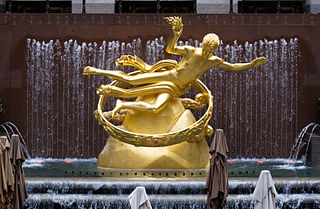
The Art Deco style, which originated in France just before World War I, had an important impact on architecture and design in the United States in the 1920s and 1930s. The most famous examples are the skyscrapers of New York City including the Empire State Building, Chrysler Building, and Rockefeller Center. It combined modern aesthetics, fine craftsmanship and expensive materials, and became the symbol of luxury and modernity. While rarely used in residences, it was frequently used for office buildings, government buildings, train stations, movie theaters, diners and department stores. It also was frequently used in furniture, and in the design of automobiles, ocean liners, and everyday objects such as toasters and radio sets. In the late 1930s, during the Great Depression, it featured prominently in the architecture of the immense public works projects sponsored by the Works Progress Administration and the Public Works Administration, such as the Golden Gate Bridge and Hoover Dam. The style competed throughout the period with the modernist architecture, and came to an abrupt end in 1939 with the beginning of World War II. The style was rediscovered in the 1960s, and many of the original buildings have been restored and are now historical landmarks.

St. Olaf Auditorium, also known as the St. Olaf Opera House and Auditorium, is a historic building located in St. Olaf, Iowa, United States. The city was able to complete the auditorium in 1939 with the assistance of the Public Works Administration (PWA) and labor provided under the aegis of the Works Progress Administration (WPA). Both are New Deal programs that sought to relieve the economic effects of the Great Depression. The building is a two-story structure composed of native rubble limestone that follows the PWA Moderne style. It has served as a community center that has hosted a variety of social activities, including recreational, athletic, cultural, educational, and civic functions. The auditorium was used occasionally for vaudeville and minstrel shows. It was listed on the National Register of Historic Places in 1994.

The Mason City Public Library is located in Mason City, Iowa, United States. The building that was funded by Andrew Carnegie, and is now an office building, was listed on the National Register of Historic Places in 1989. It was included as a contributing property in the Mason City Downtown Historic District in 2005.
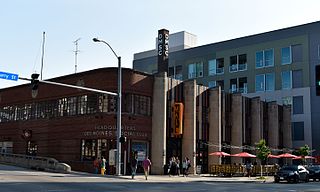
The Des Moines Fire Department Headquarters' Fire Station No. 1 and Shop Building are historic buildings located in downtown Des Moines, Iowa, United States. Completed in 1937, the facility provided a unified campus for the fire department's administration, citywide dispatch, training, maintenance, as well as the increased need for fire protective services in the commercial and warehouse districts in which the complex is located. It was designed by the Des Moines architectural firm of Proudfoot, Rawson, Brooks and Borg, and built by local contractor F.B. Dickinson & Co. The project provided jobs for local residents during the Great Depression, and 45% of its funding was provided by the Public Works Administration (PWA). The City of Des Moines provided the rest of the funds. The radio tower, which shares the historic designation with the building, was used to dispatch fire personnel from 1958 to 1978. The buildings were used by the local fire department from 1937 to 2013. It was replaced by two different facilities. The old fire station and shop building was acquired by the Des Moines Social Club, a nonprofit arts organization.
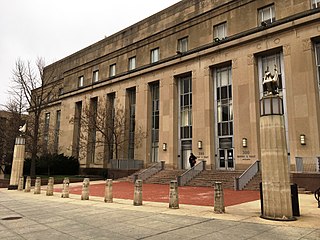
The Henry J. Daly Building is located at 300 Indiana Avenue, NW, and 301 C Street, NW, in the Judiciary Square neighborhood of Washington, D.C. The administrative building is owned by the government of the District of Columbia and has served as the home of various city offices since it opened in 1941 as a unified location for previously dispersed municipal functions. Currently, the building is primarily occupied by the Metropolitan Police Department; although the District of Columbia Department of Corrections, the District of Columbia Office of the Chief Financial Officer and the Court Services and Offender Supervision Agency (CSOSA) also maintain offices in the building.

The Brandon Auditorium and Fire Hall, on Holmes Ave. in Brandon, Minnesota, is a historic fire station and other facility. It has also been known as the Brandon Auditorium and City Hall. It was built as a Works Progress Administration project during 1935–36. It was listed on the National Register of Historic Places in 1985.

The Berwyn Health Center is a historic public health clinic at 6600 W. 26th Street in Berwyn, Illinois. Built in 1938–39, the building provided an expanded home for the city's health department. In addition to providing healthcare and leading vaccination efforts, the department was responsible for food inspection and Great Depression relief programs in the 1930s, and the new building gave it the space and resources it needed to accomplish its many duties. Along with the city's municipal building and post office, the health center was one of three buildings built in Berwyn with Public Works Administration funds in a three-year period. Architect Vladimir J. Novak, a Berwyn resident, designed the building using elements of Art Deco and Moderne architecture. Both styles were commonly used, often together, in PWA buildings; in the case of the health center, its Art Deco influence is visible in its geometric massing, while its horizontal banding is a typical Moderne feature. The building remains in use as a health clinic and government office.
























